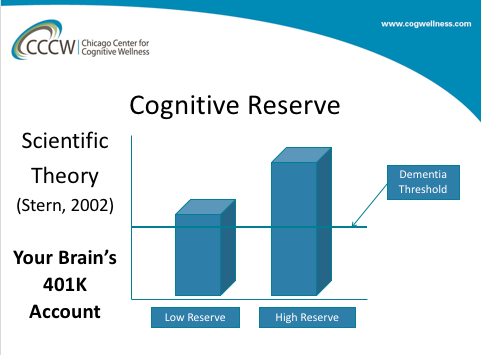We are facing a public health crisis in this country, one that lives in the shadows of shame but likely affects every one of us, particularly women. I’m talking about dementia. If you haven’t already cared for or grieved the loss of person with dementia there is a good chance you will. The projected incidence of dementia is expected to triple in the next thirty years, costing the United States an estimated 1.1 trillion (yes, t, trillion) dollars per year by 2050. These costs will bankrupt the Medicare system, and medical care only accounts for about 20% of the actual cost of a condition that takes many others down with it by way of unpaid family caregiving (most often by women), lost wages, and a 60% increase in mortality among caregivers due to stress-related disease.
Just so we are clear, dementia is a syndrome used to describe a loss of memory and/or another cognitive skill like attention or executive function that is worse than normal aging and leads to a loss of independence. Alzheimer’s disease is the most common form of dementia, but there are many other diseases and events that also cause dementia including stroke, Parkinson’s disease and even head injury. The rise in Alzheimer’s disease though is the main driver of this public health crisis, with an estimated 13 million Americans expected to have the disease in 2050, up from around 4 million in 2010.
What accounts for this epidemic? The answers are longer life and baby boomers (no offense). 10,000 baby boomers turn 65 each DAY in the United States, a trend that has been happening for a decade and is expected to continue for nearly a decade more. And what is the number one risk factor for dementia? Being over 65.
The good news is that these scary statistics will only become a reality if we sit and do nothing. If, on the other hand, we can delay the onset of dementia by just 5 years, that 1.1 trillion dollar price tag above will be cut in HALF.
Therefore, medicine is now nearly universally supporting idea that dementia is preventable in much the same way that heart disease and diabetes are preventable. You can’t control all of the risk, but you can control a lot. So let me tell you how.
Cognitive Reserve, a Household Name
I’ll start by telling you a story about brains. In the late 1980’s, a group of researchers asked older adults to donate their brain tissue when they died. The researchers had studied the people before they died. Some of the people who donated their brains were as sharp as a tac when they died while others died with very advanced signs of dementia, they couldn’t care for themselves or remember their kids’ names. The researchers wanted to know if they could tell which brains belonged in which group by counting the amount of Alzheimer’s disease plaques in the brain (beta amyloid plaques one of the two hallmark features of Alzheimer’s disease along with neurofibulary tau tangles). And what do you think they found?
If you said “more plaque in the brains of the people with advanced dementia,” you’re not alone. Many assume this, but you’re also wrong (sorry, not sorry). The researchers found the same amount of Alzheimer’s disease plaque in the brains of those who were sharp as a tac as those with advanced dementia!
The researchers (perhaps like yourself) were rather puzzled, so they sought to see if there were differences between the groups that could account for the differences in function and found that the sharp people had bigger brains and more brain tissue left over that could withstand the effects of the plaques and compensate for the cell loss. These people had also been more active throughout their lives physically, socially and intellectually.
Combining this data with similar data emerging at from stroke and brain injury, a neuropsychologist at Columbia University named Yakov Stern, PhD in the year 2000 put forth a bonafied scientific theory called Cognitive Reserve. This theory summarized what we were seeing across diseases, that the size of the stroke or the amount of disease or injury often did not predict the amount of cognitive decline. There were many people who had very small strokes and lost lots of skills, and many other people who had sustained large injuries and recovered quite well.
Cognitive Reserve Theory explains that people differ in the number of cells and skills that they have stored in their brain banks, and this, more than disease or injury, predicts the risk for dementia. The more cells and skills you have stored in your brain bank the more you can withstand changes in your memory, allowing you to maintain your independence longer.
I call Cognitive Reserve your Brain’s 401(k) because it is quite literally your brain’s retirement account. I’ve also made it my professional mission to spread the good news of Cognitive Reserve to the masses. My vision is for Cognitive Reserve to become a household name, something you think about on a daily basis, because YOU CAN CONTROL IT!
[Scientific Disclaimer]: Well you can control a decent amount of it. There do seem to be people who are born with brain trust funds, those with genetically bigger brains, and unfortunately you can’t go back and re-live your 20’s and drink less beer, but you can control a lot! Also Cognitive Reserve is not just important to older adults. We all need to think about this across the entire lifespan. No self-respecting financial planner would tell you to start saving for retirement at 50, right?
How to Maximize Your Brain 401(k) Investing
Early in the days of understanding this theory a lot of focus was put on minimizing losses, but now we know that you can actively invest in your Brain 401(k) throughout your life. This is the result of a radical change in neuroscience called Positive Brain Plasticity. Contrary to what we used to think, that we have all the brains we are ever going to have at 20 and it’s all downhill from there, we now know that the adult brain can continue to grow and change in positive ways throughout the entire lifespan.
Did you know that adults grow new brain cells? We do! We don’t grow a lot, so it is important to hold onto the ones you have, but we do grow new brain cells in and around the memory centers in our brains, and our brains can get bigger (or smaller) based on how we use it.
If I were to list out for all of the ways that you can improve your Brain 401(k) investing, you would grow so bored of me; there are that many ways. But if I had to boil it down to 3 things…
Dr. All’s Top 3 Strategies for Maximizing Brain 401(k) Investing
1. Move Your Body: Physical activity is the A-#1 best way to improve your brain health. Not only does it improve your cardiovascular health (and what’s good for your heart is good for your brain), but we also have experimental evidence (the best type of data) that shows that being physically active helps you grow more brain cells. Not only that we have watched brain regions grow (in humans!) as a result of starting an exercise routine! So go move your body!!
2. Learn Something New: You don’t have to take up the New York Times crossword or do Sudoku until you’re cross-eyed (unless you like these), but having an active mental life is important for building your Brain’s 401(k). Baby brain cells have to be “trained” to become new neuron. These new cells start off as stem cells, cells that can take on any job in the body. If they are not stimulated by neighboring neurons, they die. Stimulation comes by activating your memory centers and learning new things.
3. Manage Stress: The stress hormone cortisol is toxic to brain cells. It stops your brain from growing new ones and kills off the ones you have. You can’t get rid of all of our stress, nor should you. Our bodies are made to fluctuate between states of periodic fight-or-flight (stress or excitement – they’re the same in the body) balanced by rest-and-digest, but far too many humans get stuck in fight-or-flight. These two states cannot be active at the same time, so a good way to give your brain a break from the toxic effects of cortisol is to put yourself into rest-and-digest through slowing the breath, releasing muscle tension, yoga, meditation, etc.
I think you can do this. Don’t you? You don’t have to start them all at once. Perhaps you’re already doing all 3, in which case, WAY TO GO! But you’re also smoking? Well in that case I guess we need talk (wink, no judgment). Contact me at 855-264-9355, ext 101 (855-COGWELL) or sall@cogwellness.com.
We are all in this journey to better brain health together. I wish you many moments of good health and warm memories. Namaste.
Content provided by Women Belong member Sherrie All










































 Women Belong Holiday Party - ZOOM
Women Belong Holiday Party - ZOOM Why Your Business Wants You To Do Yoga
Why Your Business Wants You To Do Yoga Women Belong Book Club
Women Belong Book Club Why Heroine?
Why Heroine? Follow up with Flow: Creating a Follow Up Funnel that Feels Easy
Follow up with Flow: Creating a Follow Up Funnel that Feels Easy